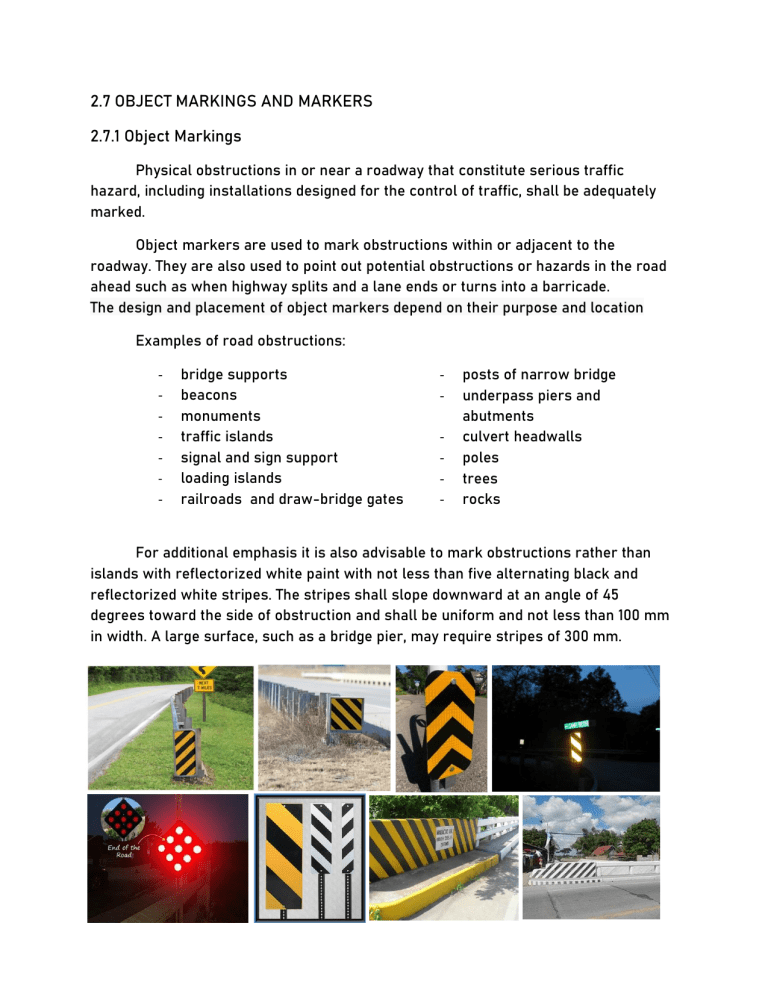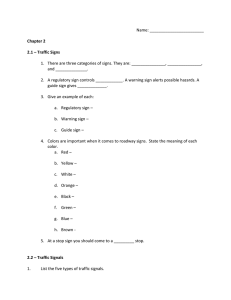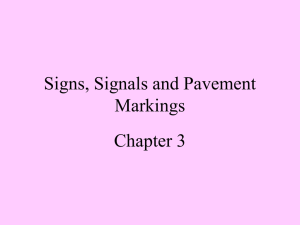
2.7 OBJECT MARKINGS AND MARKERS 2.7.1 Object Markings Physical obstructions in or near a roadway that constitute serious traffic hazard, including installations designed for the control of traffic, shall be adequately marked. Object markers are used to mark obstructions within or adjacent to the roadway. They are also used to point out potential obstructions or hazards in the road ahead such as when highway splits and a lane ends or turns into a barricade. The design and placement of object markers depend on their purpose and location Examples of road obstructions: - - bridge supports beacons monuments traffic islands signal and sign support loading islands railroads and draw-bridge gates - posts of narrow bridge underpass piers and abutments culvert headwalls poles trees rocks For additional emphasis it is also advisable to mark obstructions rather than islands with reflectorized white paint with not less than five alternating black and reflectorized white stripes. The stripes shall slope downward at an angle of 45 degrees toward the side of obstruction and shall be uniform and not less than 100 mm in width. A large surface, such as a bridge pier, may require stripes of 300 mm. OTHER SIGNS In addition to the marking on the face of an obstruction in the roadway, warning of approach to the hazard shall be given by line markings on the pavements. Reflectorized yellow should be used in curbs of all islands located in the line of traffic flows especially on curbs directly ahead of traffic at T and offset intersections. ROAD MARKINGS AND LINES There are many forms of road markings and lines. Road markings and road lines can be found along the road or across the road to provide awareness to hazards, to give drivers rules or for directions. Basic Road Lines Meaning in the Philippines - Must-know to Drive Safely 1. Solid White Shoulder Line Solid white shoulder line is used to separate traffic between two traffic streams. This denotes the edge of the roadway. Any asphalt or concrete surface beyond this line should not be used during the normal operation of your vehicle. 2. Diagonal White Line White diagonal lines are usually outlined by a solid white line. Vehicles must not occupy these areas unless there is an emergency. These areas are often used to ease traffic when roads diverge or intersect. 3. Broken White Line These lines can be seen in two situations. One is when you're on a two-lane road. The dashed white line represents the centers of the two lanes. Second, on a road with multiple lanes, these road line markings meanings drivers should stay in their lanes. You can cross these lanes when you want to pass, but be aware of people already in that lane. 4. Solid White Center Line This is often used to divert traffic on a two-way multi-lane road. Since this is a solid line, you should not cross it unless the line is completely clear. 5. Solid White Double Center Line You are forbidden from overtaking over this line, but you may make left turns over it, provided the way is clear. Remember, however, that oncoming traffic still automatically has right of way. 6. Solid Yellow Double Center Line This road marking indicates that it is not safe to pass at any time. It is often found around hidden bends or in areas where fast-moving two-way traffic meets on a road without a median. 7. Mixed center line/solid yellow with broken yellow or white line These transition lines road indicate that only one side can cross - the side with the broken line. This is often found when entering curves where visibility is obscured from one direction, but clear from the opposite. 8. Directional arrows When combined with a solid white divider, directional arrows indicate which directions you are allowed to go in a lane. If the arrow points forward, you cannot turn from that lane. If it's facing forward and sideways, you can go straight or turn. If it is only going to one side, you must turn in that lane. Ignoring these arrows could just land you a fine or worse, get you into an accident. 9. Rumble strips These tightly spaced white horizontal lines not only give your car's suspension a softer look, but also indicate hazards ahead, such as treacherous bends or merging traffic. 2.7.2 Raised Pavement Markers 10. Solid White Horizontal Line This indicates where you must stop at a spotlight or stop sign. 11. Pedestrian/ Zebra Crossings This indicates a pedestrian crossing zone. This is a crossing type where vehicle traffic is required to give way to pedestrians approaching or using the crossing. Stopping over this at a red light is a traffic violation, so make sure to pay attention to those light timers. 12. Yellow box This box indicates that the intersection must always be open by law. Even if you have a green light, if traffic is stopping on the other side ahead, it is best to wait until there is enough space for you to pass the yellow box. Even in the absence of light, the yellow box must be kept clear. 2.7.2 Raised pavement markers - are small rectangular or dome-shaped devices that are fixed to the pavement surface to simulate or supplement painted pavement markings can be reflective or nonreflective Raised pavement markers are generally not obscured at night and under wet conditions. The reflective types are more brilliant than reflectorized paint markings. Because of high cost of installation and maintenance, use of raised pavement markings may be considered only in accident-prone areas, e.g., on hilly areas where there is frequent fog and rain. Hazard markers Hazard markers - - are rectangular and generally consist of a series of alternating black and white bands white portion is always reflectorized, but the reflectorized material may cover only the central portion of each white band in order to achieve a balance between the areas of black and white under headlight illumination bands may consist of either diagonal strips where only a target is required or of chevrons where directional as well as target properties are desirable Chevron Markers HAZARD MARKER SIGNS Delineators Delineators - small reflective panels or buttons mounted on guide posts or guard fences as an effective aid for night driving made of reflective material capable of reflecting light clearly visible under normal atmospheric condition from a distance of 300-500 m when illuminated by the upper beam Traffic cones and other traffic delineators are designed to be modular so they can be easily placed and removed. While orange is the most common color, it is not the only color used. Button mounted on guide post Reflective Buttons REFERENCES Basic road lines meaning Philippines - must-know to drive safely. (n.d.). philcarreview.com. https://philcarreview.com/safe-driving/10-basic-road-linesmeaning-philippines-must-know-to-drive-safely-ta177 Fundamentals Of Traffic Engineering - Ricardo G. Sigua.pdf [z0xj8n36noln]. (n.d.). Doku.pub. https://doku.pub/documents/11-fundamentals-of-traffic-engineeringricardo-g-siguapdf-z0xj8n36noln

